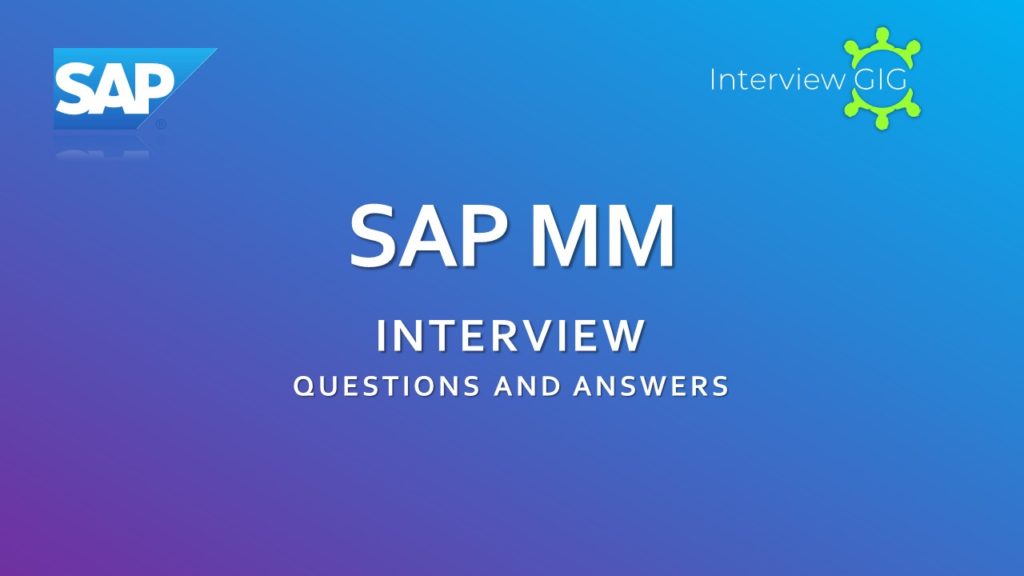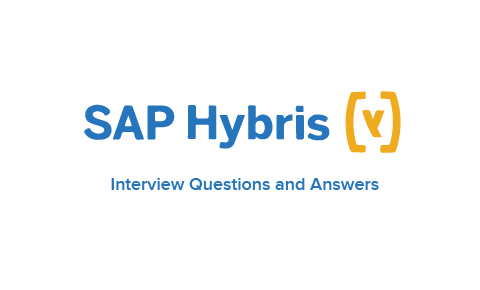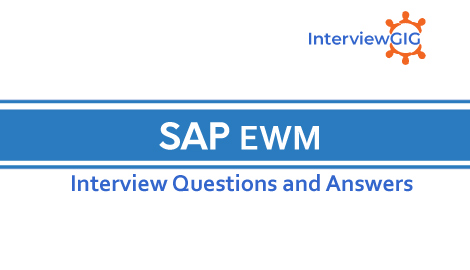SAP ABAP Interview Questions and Answers for Freshers & Experienced Candidates
SAP ABAP (Advanced Business Application Programming) is a high-level programming language developed by SAP for building business applications in the SAP environment. ABAP is a key component of SAP’s NetWeaver platform and is primarily used to develop custom reports, interfaces, enhancements, and forms within SAP applications.
ABAP enables developers to create complex business logic and manipulate data stored in SAP databases. With its rich set of features and extensive integration capabilities, ABAP plays a crucial role in extending and customizing SAP solutions to meet specific business requirements.
Here, we have listed all the Top SAP ABAP Interview Questions and Answers for Fresher’s
Question: What do you know about SAP ABAP? and how to use?
Answer: SAP ABAP (Advanced Business Application Programming) is a high-level programming language developed by SAP for building business applications within the SAP environment. It’s primarily used for developing custom reports, interfaces, enhancements, and forms within SAP applications. ABAP allows developers to create complex business logic, manipulate data stored in SAP databases, and customize SAP solutions to meet specific business needs.
Here’s a breakdown of how ABAP is used:
Developing custom applications: ABAP allows creating reports, interfaces, workflows, and data manipulations specific to your business needs.
Modifying standard SAP functionality: You can tailor existing SAP functionalities to better suit your processes.
Data access and manipulation: ABAP interacts with SAP databases to retrieve, process, and update data.
Question: Write a simple ABAP program to display the current date?
Answer: To display the current date in ABAP, you can use the following simple program:
REPORT Z_DISPLAY_CURRENT_DATE.
DATA: current_date TYPE sy-datum.
GET TIME.
current_date = sy-datum.
WRITE: / 'Current Date:', current_date.
This program retrieves the current system date using the sy-datum system field and then displays it using the WRITE statement.
Question: What is an ABAP/4 Query?
Answer: An ABAP/4 Query is a tool within SAP that allows users to create simple reports without needing to write ABAP code. It provides a graphical interface for defining queries against the database tables and fields within an SAP system. Users can define selection criteria, sorting, grouping, and aggregation rules using a user-friendly interface, and then execute the query to retrieve the desired data. ABAP/4 Query simplifies the process of generating ad-hoc reports within SAP environments, making it accessible to users with limited technical expertise. ABAP/4 queries are a good option for basic reporting needs.
Question: What are the Control Flow statements in ABAP?
Answer:
Control Flow Statements in ABAP:
- IF statement: Used for conditional execution. It evaluates a condition and executes a block of code if the condition is true.
- CASE statement: Similar to a switch statement in other programming languages. It allows for multi-way branching based on the value of an expression.
- LOOP statement: Used for iterative processing. There are various types of loops in ABAP such as DO loops, WHILE loops, and FOR loops, each serving different looping purposes.
- WHILE statement: Executes a block of code repeatedly as long as a condition is true.
- DO statement: Executes a block of code repeatedly until a condition becomes false.
- FOR statement: Executes a block of code for a specified number of iterations
Question: How do you handle exceptions in ABAP programs?
Answer: ABAP provides mechanisms to handle errors that might arise during program execution. Here’s how you can handle exceptions:
TRY… CATCH… ENDTRY: This block structure allows you to define a code section (TRY block) where exceptions might occur and following CATCH blocks to handle specific exceptions or a general category (OTHERS). A CLEANUP block can be used for actions to be executed regardless of exceptions.
ABAP
TRY.
OPEN DATASET some_file FOR INPUT.
... process data from file ...
CLOSE DATASET some_file.
CATCH system-exceptions cx_file_not_found = 1.
WRITE: / ‘Error: File not found!’.
ENDTRY.
RAISE EXCEPTION: This statement allows you to deliberately raise an exception within a program to signal an error condition. It can be used with a message to provide more context about the error.
Question: What are function modules and how are they used?
Answer: Function modules are reusable blocks of code that perform a specific task and can be called from other ABAP programs or function modules. They encapsulate business logic and are similar to functions or procedures in other programming languages.
- Creating Function Modules: Function modules are created using the Function Builder (SE37 transaction) in the ABAP Workbench.
- Types of Function Modules: There are two types of function modules:
Remote-Enabled Function Modules: Can be called from external systems.
Local Function Modules: Can only be called from within the same SAP system.
- Using Function Modules: Function modules are called using the CALL FUNCTION statement. Input parameters can be passed to the function module, and it may return output parameters or values.
Question: Can you explain the purpose of the data dictionary in ABAP?
Answer: The Data Dictionary in ABAP serves as a central repository for managing data definitions used in SAP applications. Its primary purpose is to define and maintain data structures such as tables, views, data elements, domains, and search helps.
Some key functions of the Data Dictionary include:
Centralized Data Management: It provides a single point of access and control for defining and managing data elements and structures used across different ABAP programs.
Data Integrity: The Data Dictionary ensures data integrity by enforcing data type and domain constraints defined at the database level.
Consistency: It promotes consistency by providing standardized data definitions that can be reused across multiple applications.
Data Documentation: The Data Dictionary allows developers to document data structures, providing information about their purpose, usage, and relationships
Question: What are the different types of Tables in ABAP?
Answer: In ABAP, there are three main types of tables:
-
- Transparent Tables: These tables directly correspond to a single database table. Data in transparent tables is stored in the database and can be accessed using standard SQL commands.
- Pool Tables: Pool tables are logical tables that are stored in a common table pool. They are used to store control data shared by multiple programs.
- Cluster Tables: Cluster tables are used to store application-specific data that is frequently accessed together. Unlike transparent tables, cluster tables store data in a compressed format to improve performance.
Question: Explain the key concepts of object-oriented programming in ABAP.
Answer:
Key Concepts of Object-Oriented Programming (OOP) in ABAP:
ABAP supports object-oriented programming (OOP) principles, including encapsulation, inheritance, and polymorphism. Some key concepts include:
-
- Classes: Classes are blueprint templates for creating objects. They define the properties and behavior of objects.
- Objects: Objects are instances of classes. They encapsulate data and behavior defined by their class.
- Methods: Methods are procedures or functions defined within a class that perform specific tasks or operations.
- Attributes: Attributes are variables defined within a class that hold data associated with objects of that class.
OOP in ABAP allows for modular, reusable, and maintainable code by promoting encapsulation, inheritance, and polymorphism principles.
Question: How do you implement inheritance and polymorphism in ABAP?
Answer: Inheritance and polymorphism are fundamental concepts in object-oriented programming (OOP), supported in ABAP.
Inheritance: In ABAP, you can create a new class (subclass) based on an existing class (superclass) using the INHERITING FROM statement. The subclass inherits attributes and methods from the superclass and can override methods or add new ones.
Polymorphism: Polymorphism allows objects of different classes to be treated as objects of a common superclass. In ABAP, polymorphism is achieved through method redefinition. Subclasses can redefine methods inherited from superclasses to provide specific implementations.
Question: What are interfaces and how are they used?
Answer: Interfaces in ABAP define a contract specifying which methods a class must implement. They declare a set of method signatures without providing implementations. Any class that implements an interface must provide implementations for all methods declared in the interface. Interfaces are defined using the INTERFACE statement and implemented by classes using the INTERFACES keyword.
Question: How do you define foreign key relationships between tables?
Answer: In ABAP, foreign key relationships between tables are defined using the Data Dictionary (SE11). When creating or modifying a table, you can specify foreign key constraints in the Table Maintenance Dialog. These constraints define the relationship between fields in different tables, enforcing referential integrity at the database level.
Question: How do you debug ABAP programs?
Answer: ABAP programs can be debugged using the ABAP Debugger (/H). By inserting breakpoints or watchpoints in the code, developers can pause program execution at specific points to inspect variables, check program flow, and identify errors. ABAP offers a robust debugging toolkit to streamline error identification and resolution:
- SET BREAK-POINT: Strategically placed break-points allow you to pause program execution at specific lines for in-depth inspection.
- DISPLAY: This statement facilitates the examination of variable values during program execution, aiding in pinpointing the source of errors.
- Debugger: The ABAP debugger provides a step-by-step execution environment with variable inspection capabilities, enabling you to meticulously trace program flow and identify issues.
Question: What are Smart Forms and SAP Scripts?
Answer:
Smart Forms: Smart Forms provide a user-friendly WYSIWYG editor for creating interactive PDF forms within the ABAP environment. This empowers you to design professional and user-centric forms that enhance data collection and presentation.
SAP Scripts: For text-based output generation, SAP scripts offer a well-established approach. They are ideal for creating formatted documents like invoices or reports with a high degree of control over the layout and content.
Question: Can you define BAPI and its uses.
Answer: BAPIs (Business Application Programming Interfaces) are standardized interfaces provided by SAP to interact with SAP business objects and processes. They encapsulate business logic and allow external systems to access SAP functionality in a consistent and controlled manner. BAPIs enable integration between SAP and external applications, facilitating tasks such as data exchange, transaction processing, and workflow automation. Common BAPI use cases include:
- First Creating sales orders
- Next Managing customer data
- Posting financial transactions
Question: What is Application Link Enabling (ALE) and how is it used for data exchange?
Answer: ALE is a technology in SAP that enables distributed systems to exchange data asynchronously. It provides mechanisms for data replication, distribution, and communication between SAP systems and external systems. ALE uses distributed model and message-based communication to ensure consistency and reliability in data exchange processes.
ALE is instrumental for:
Replicating data across systems (e.g., customer data)
Sending and receiving business documents (e.g., purchase orders)
Question: Explain the concept of custom objects and events in ABAP.
Answer: Custom objects and events in ABAP allow developers to extend standard SAP functionality by defining new objects and triggering custom events. Custom objects are created using ABAP classes or data dictionary elements, while events are defined within these objects to trigger specific actions. Custom objects and events enable modular and customizable development in SAP applications.
Question: Explain the use of function modules in ABAP. How are they different from subroutines?
Answer: Function Modules: Reusable Powerhouses
Function modules are the workhorses of modular programming in ABAP. They are self-contained, reusable code units that perform specific tasks.
Key characteristics include:
Import/Export Parameters: Allow data to be passed into and out of the function module.
Internal Logic: Encapsulate the processing steps within the function module.
Return Values: Can optionally return a value to the calling program.
Reusability: The biggest advantage! Function modules can be called from anywhere in your ABAP code, promoting code reuse and reducing redundancy.
Function Modules vs. Subroutines: Know the Difference
While both function modules and subroutines can group reusable code blocks, function modules offer several advantages:
Data Encapsulation: Function modules can hide internal data structures, protecting them from unintended modifications and promoting better data integrity.
Parameter Interface: Function modules clearly define input and output parameters, improving code readability and maintainability for developers.
Error Handling: Function modules can handle exceptions and return error codes, providing a more robust mechanism for error management.
Question: What is the Purpose of LOCK Objects in ABAP:
Answer: LOCK objects in ABAP are used to manage concurrent access to shared resources, such as database tables, in a multi-user environment. By acquiring locks on LOCK objects, developers can ensure that only one user can modify a shared resource at a time, preventing data inconsistencies and conflicts. LOCK objects help maintain data integrity and ensure that transactions are executed in a controlled and consistent manner.
Question: How do you handle errors and exceptions in ABAP programming?
Answer: Errors and exceptions in ABAP programming can be handled using the TRY, CATCH, and ENDTRY statements. The TRY block contains the code where exceptions may occur, and the CATCH block handles these exceptions by providing appropriate error handling or recovery mechanisms. Developers can catch specific exceptions or catch all exceptions using the CX_ROOT class. Additionally, ABAP provides tools such as the ABAP Debugger and runtime analysis tools for identifying and debugging errors in programs.
Question: What is Web Dynpro applications and how are they developed in ABAP?
Answer: Web Dynpro is a development framework within ABAP for creating dynamic web applications that seamlessly integrate with SAP data and functionalities. It offers a visual interface for designing user interfaces and utilizes ABAP for server-side logic.
Here’s a simplified development process:
Design the User Interface: Use the Web Dynpro builder to create the web application’s layout using drag-and-drop components and data binding.
Develop Server-Side Logic: Implement the application’s business logic using ABAP within Web Dynpro controllers.
Deployment and Access: Deploy the Web Dynpro application to the SAP NetWeaver server, making it accessible through a web browser.
Web Dynpro applications enhance user interaction and extend SAP functionalities to a wider audience through web interfaces.
Question: Can you explain the benefits and considerations when developing ABAP applications for SAP HANA?
Answer:
Benefits:
Improved Performance: ABAP applications running on SAP HANA benefit from in-memory computing, resulting in faster data access and processing.
Real-time Analytics: SAP HANA’s advanced analytics capabilities enable real-time data analysis and reporting within ABAP applications.
Simplified Development: SAP HANA provides native integration with ABAP, allowing developers to leverage HANA-specific features such as advanced SQLScript for developing high-performance applications.
Considerations:
Data Modelling: ABAP developers need to understand SAP HANA’s data modeling concepts and best practices for designing efficient data models.
Code Optimization: Developers should optimize ABAP code to take advantage of SAP HANA’s in-memory computing capabilities, such as using optimized database access techniques and avoiding unnecessary data processing.
Compatibility: Not all ABAP applications may be compatible with SAP HANA, and modifications may be required to ensure compatibility and optimal performance.
Question: Can you explain how ABAP can be used for integrating SAP applications with cloud-based services?
Answer: ABAP can facilitate the integration of SAP applications with cloud-based services, including Cloud Application Programming Interfaces (APIs). Through ABAP, developers can leverage various techniques such as HTTP requests, web services, and RESTful APIs to communicate with cloud services. For instance, ABAP can consume APIs provided by cloud platforms like SAP Cloud Platform or third-party services like Salesforce or Google Cloud. Developers can use ABAP to send and receive data between SAP systems and cloud services, enabling seamless integration and interoperability across hybrid landscap.
Question: How can ABAP be used to create Fiori applications for a modern user experience in SAP?
Answer: Fiori is SAP’s next-generation user experience (UX) for SAP applications. Here’s how ABAP plays a role in Fiori development:
- Fiori Elements and Apps: SAP provides pre-built Fiori elements (controls, layouts) and even complete Fiori applications that you can leverage.
- ABAP for Fiori Extensions: If needed, develop custom Fiori applications or extend existing ones using ABAP. You can create server-side logic to process data and interact with SAP services.
- ABAP and SAP NetWeaver Gateway: The SAP NetWeaver Gateway acts as a middle layer between Fiori applications and backend systems like those powered by ABAP. It translates data and handles communication.
By using ABAP for Fiori development, you can create modern, user-friendly interfaces for your SAP applications.
Question: How do security considerations differ when developing ABAP applications for a cloud environment?
Answer: Security considerations differ when developing ABAP applications for the cloud:
- Shared Responsibility Model: Cloud providers typically manage the underlying infrastructure security, but the application code (ABAP in this case) remains your responsibility.
- Data Encryption: Ensure sensitive data is encrypted both at rest and in transit between your ABAP application and cloud services.
- Authorization and Access Control: Implement strong authorization checks within your ABAP code to control access to data and functionalities based on user roles.
Question: Explain how ABAP development practices can be integrated with DevOps methodologies for continuous integration and delivery.
Answer: DevOps methodologies promote collaboration between development and operations teams. Here’s how ABAP development can integrate with DevOps:
- Version Control Systems: Use version control systems like Git to manage ABAP code changes and enable collaboration.
- Continuous Integration (CI): Implement CI pipelines that automate ABAP code testing and building upon every commit, ensuring quality.
- Continuous Delivery (CD): Set up CD pipelines to automate the deployment of tested ABAP code to cloud or on-premise environments.
By integrating ABAP development with DevOps, you can achieve faster release cycles and deliver applications more efficiently.
Question: Can you explain integrating machine learning algorithms into ABAP programs for data analysis.
Answer: SAP offers libraries and frameworks such as SAP Leonardo and SAP Predictive Analytics that enable developers to embed machine learning models directly within ABAP applications. Machine learning (ML) algorithms can be integrated into ABAP programs for data analysis:
- Utilize External ML Services: Cloud services or external libraries can provide pre-trained ML models that you can leverage within your ABAP code.
- ABAP Code Integration: Use ABAP statements to call these ML services, providing data for analysis and receiving results (predictions, classifications).
By integrating ML with ABAP, you can uncover valuable insights from your data and automate decision-making processes within SAP applications.
Question: What’s the purpose of BDCs and their use cases for data transfer between external systems and SAP?
Answer: Batch Data Communication (BDC) is a technique used for transferring data between external systems and SAP applications in a batch mode. BDC involves recording and processing data in batches rather than interactively. BDC programs typically utilize transaction recordings or direct input methods to input data into SAP screens or execute predefined transactions. Use cases for BDC include mass data uploads, data migration, and integration with legacy systems that lack standard interfaces. BDC enables organizations to automate data transfer processes, improve data accuracy, and streamline business operations.





